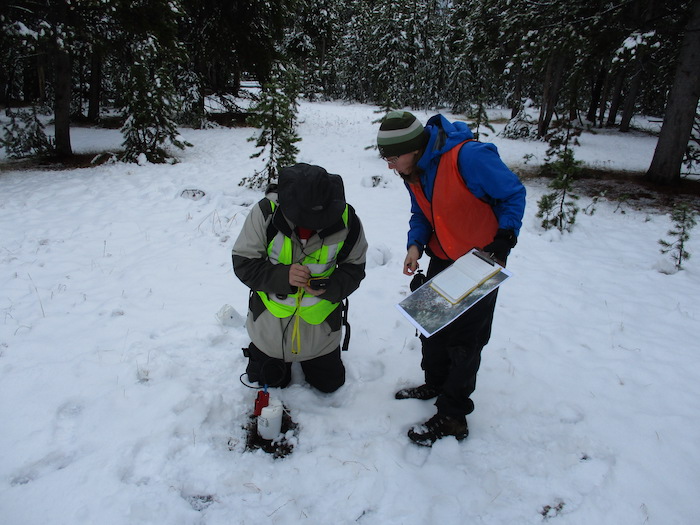
UTEP Geology Professor’s Research Contributes to New Data on the World’s Tallest Active Geyser
Last Updated on January 26, 2021 at 12:00 AM
Originally published January 26, 2021
By Christina Rodriguez
UTEP Communications
The work of a faculty member from The University of Texas at El Paso is helping build understanding of the recent reactivation of Steamboat, the world’s tallest active geyser located at Yellowstone National Park.

Marianne Karplus, Ph.D., assistant professor of geological sciences, is part of an interdisciplinary team of researchers led by the University of California, Berkeley, that is studying eruption mechanisms of the giant geyser and learning more about possible causes and outcomes of its latest flare-up, which began in 2018 after years of sporadic activity. That year, Steamboat reawakened in a spectacle of surging water and steam, reaching heights of more than 300 feet off the ground during one of its more than 100 major eruptions in recent years.
“Dr. Karplus’ research on geysers and earthquakes is an excellent example of the significant contributions being made by UTEP’s College of Science,” said Robert Kirken, Ph.D., dean of UTEP’s College of Science. “Her research is helping scientists understand the timing and extent of earth processes that are difficult to predict, but sometimes impact humans in hazardous ways. In this project and others, she collaborates with well-known scientists, elevating the reputation of UTEP in the U.S. and around the world.”
Karplus joined the research team studying Steamboat at the Cooperative Institute for Dynamic Earth Research (CIDER) summer program held at Berkeley in 2019. The center brings together senior scientists, faculty, doctoral students and postdoctoral researchers from throughout the world.
“We formed this group to look at Steamboat Geyser in particular because it just recently started erupting again for the first time in several decades,” Karplus said. “We wanted to answer a few questions related to why the activity started in 2018 and whether there was any connection with earthquakes in the area. We looked at a lot of different data types as part of that group and continued working together after the summer program at Berkeley for about a year with weekly remote calls to discuss data and try to figure out the answers to our questions.”
The study aimed to answer three main questions — why Steamboat started erupting again in 2018; what controls the intervals between eruptions; and what factors make Steamboat the biggest geyser in the world. Karplus was part of the group that looked at seismic and global positioning system (GPS) data to see if there was a correlation between earthquakes, ground motion and the geyser’s eruption.
The team discovered evidence to rule out certain natural events such as earthquakes and snowfall as contributing factors to the geyser’s reawakening and determined there are no indications of future volcanic eruptions or activity in the nearby geyser basin ignited by Steamboat’s activity.
The Steamboat research was led by UC Berkeley graduate student and first author Mara Reed. Additional co-authors include Carolina Munoz-Saez of the University of Chile and Columbia University in New York, Sahand Hajimirza of Rice University, Sin-Mei Wu of the University of Utah, Anna Barth of Columbia University, Társilo Girona of the University of Alaska, Majid Rasht-Behesht of Brown University, Erin White of Yellowstone National Park, Shaul Hurwitz of the U.S. Geological Survey in California, and Michael Manga of UC Berkeley. The work was supported by the National Science Foundation.
Karplus is optimistic that the findings of this study will help contribute to a better understanding of geyser systems and help answer some of the still pressing questions about the mechanisms of Steamboat. She will use portions of the knowledge acquired from this study to advance her research on Old Faithful and other geothermal projects.
“Having UTEP researchers participate in these kinds of big international interdisciplinary projects that cover research topics of interest to a broad range of scientists reflects UTEP’s R1 (top tier research university) status,” Karplus said. “It also helps bring research dollars to the University to support our graduate students and continue high-profile research on geothermal systems.”
Karplus has worked on several geothermal research projects since arriving at UTEP in 2015. One of her main areas of interest and expertise is studying the internal systems and processes of geysers such as Old Faithful, another popular Yellowstone geyser, using geophysics and seismology methods. She has supervised several UTEP students, including current doctoral student Jordan Caylor, who is studying the geologic and hydrologic systems beneath Old Faithful and collecting new seismic data in Yellowstone in collaboration with The University of Utah.
